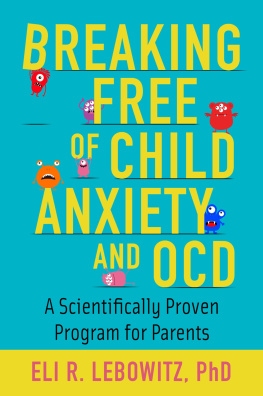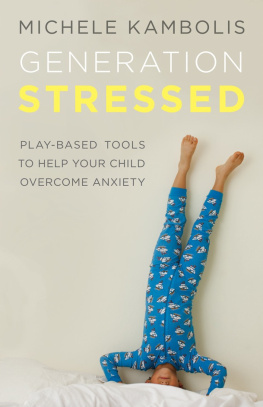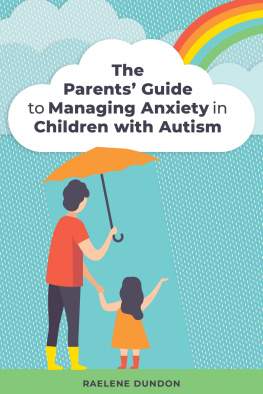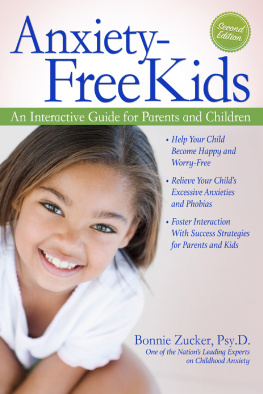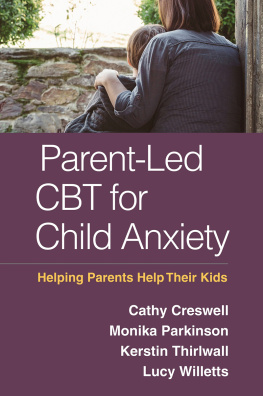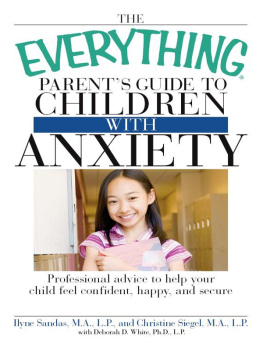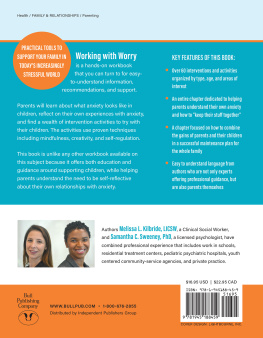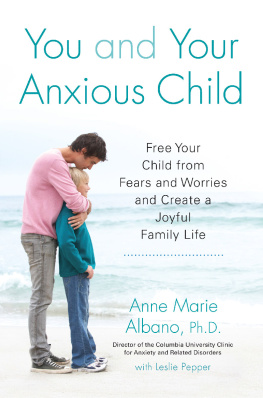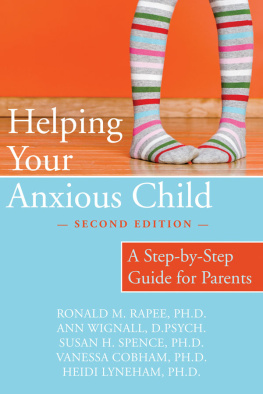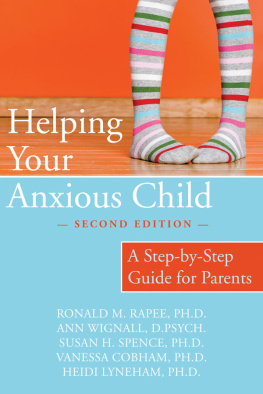BREAKING FREE OF CHILD
ANXIETY AND OCD

Oxford University Press is a department of the University of Oxford. It furthers the Universitys objective of excellence in research, scholarship, and education by publishing worldwide. Oxford is a registered trade mark of Oxford University Press in the UK and certain other countries.
Published in the United States of America by Oxford University Press
198 Madison Avenue, New York, NY 10016, United States of America.
Oxford University Press 2021
All rights reserved. No part of this publication may be reproduced, stored in a retrieval system, or transmitted, in any form or by any means, without the prior permission in writing of Oxford University Press, or as expressly permitted by law, by license, or under terms agreed with the appropriate reproduction rights organization. Inquiries concerning reproduction outside the scope of the above should be sent to the Rights Department, Oxford University Press, at the address above.
You must not circulate this work in any other form and you must impose this same condition on any acquirer.
Library of Congress Cataloging-in-Publication Data
Names: Lebowitz, Eli R., author.
Title: Breaking free of child anxiety and OCD : a scientifically proven
program for parents / Eli R. Lebowitz.
Description: New York, NY : Oxford University Press, 2021. |
Includes bibliographical references and index.
Identifiers: LCCN 2020016659 (print) | LCCN 2020016660 (ebook) |
ISBN 9780190883522 (paperback) | ISBN 9780190883546 (epub)
Subjects: LCSH: Anxiety in childrenTreatmentPopular works. |
Obsessive-compulsive disorder in childrenTreatmentPopular works. |
Child rearingPopular works.
Classification: LCC RJ506.A58 L43 2021 (print) | LCC RJ506.A58 (ebook) |
DDC 618.9285/227dc23
LC record available at https://lccn.loc.gov/2020016659
LC ebook record available at https://lccn.loc.gov/2020016660
Contents
My Child Is Struggling with Anxiety, Can You Help?
This is a question I get asked very frequently by parents of children and adolescents coping with elevated anxiety. This book answers that question by saying, YOU can help your child! If you are the parent of a child with anxiety or obsessive-compulsive problems, it is my hope that by following the steps described in these pages, you will be able to significantly reduce your childs anxiety and improve their quality of life.
The steps laid out in this book are a systematic treatment approach that has been tested in clinical trials and found to be very effective. The name of the treatment program is SPACE, which stands for Supportive Parenting for Anxious Childhood Emotions. What many parents find most exciting about SPACE, and what makes it most different from other child anxiety treatments, is that it focuses entirely on parents and provides them with the tools to help their children. In fact, heres a promise: At no point in this book will parents be required to pressure their children into doing things they dont want to do. In working through this book, youll only be trying to change the behavior of the one person you can control the most, yourself.
Before going any further lets do away with a common myth about childhood problems; namely, that childhood problems are caused by parents, and if your child has an anxiety problem this is probably due to something you did wrong, or to something you should have done but did not. In , I address this myth and explain why it is simply not the case. The desire to help your children live the best lives they can live, and to overcome challenges they face, is completely separate from the notion that you as a parent caused your childs difficulties. Once you think about it this way, it becomes obvious that the two things differ. After all, why would a parent only want to help a child with problems the parent had caused? It makes no sense! Likewise, the fact (and it is a fact) that parents can be helpful to their anxious children does not mean that the parents caused the anxiety. Why should parents only be able to impact problems they caused? That also makes no sense. So whether you blame yourself for your childs anxiety, or somebody else blames you for it, or you think that I blame you for it by suggesting you have the power to help your child, lets do away with the myth that you are the cause of your childs anxiety.
Like many other treatments, SPACE is a systematic program in which each step builds on previous steps in an organized way. For this reason, the best way to use this book is to read through the whole book and follow the suggestions in the order they are presented. It can be tempting to jump ahead or skip over steps, especially as you are probably eager to get going and see your childs anxiety improve as soon as possible. But you and your child are most likely to have the best success if you follow each step in order. Taking the time to complete all the steps, and making use of the accompanying worksheets, is really the best way to accomplish your goal of helping your child be less anxious.
Although working through each step takes time, its useful to remember that treating childhood anxiety always takes time and for a brief description of CBT), also rely on regular weekly meetings with a therapist and require a lot of work both in the sessions and between them. So dont shortchange yourself when working independently with a book such as this one. Put in the effort and devote the time so that you can be sure you are giving yourself the best chance of success. One suggestion is to commit to your own session time, setting aside an hour a week, which you (and your partner when working together) will devote to working on this book and thinking about the progress you are making.
Of course, even with substantial time and effort, working with a book cant completely substitute for skilled therapy from an expert clinician. This book contains tools and suggestions that will likely be sufficient for many parents to have a meaningful impact on their childs anxiety. But if you realize that the book is not enough, or if you find that you need more help, then working together with a professional mental health provider who is knowledgeable about child anxiety and experienced in treating it may be the best option.
And finally, thank you! Thank you for being a parent who is sensitive to your childs needs and devoted to helping your child. You are holding a book that is written for parents who want to help their child. Your sensitivity has helped you understand that your child is coping with anxiety, and your dedication has led you to seek out ways to help them. So, thank you!
What Is Anxiety?
Anxiety is a word we use to describe the system that helps us become aware of possible threats and dangers and keeps us safe from those threats and dangers. All living things, from the simplest life forms to complex animals and human beings, have systems whose job it is to tell the difference between things that are safe and things that might be harmful. Being able to make this distinction is critical to staying alive and healthy. Some animals use their sense of smell to determine whether a food is safe to eat, whereas others listen to the sounds around them to decide it is safe to leave a protected spot.
We human beings also use our senses to keep out of trouble, such as when we jump at a loud noise, look both ways before we cross the street, or sniff a yogurt container to decide whether it smells good enough to eat. Human beings also can react to threats that are not actually present and that cannot be detected by our senses. Our unique ability to

